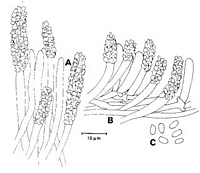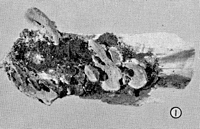|
 Junghuhnia rhinocephalus Junghuhnia rhinocephalus
SynonymsMetuloidea tawa
Trichaptum rhinocephalus
Polyporus rhinocephalus
Trametes tawa
Trichaptum tawa
BiostatusPresent in region - Indigenous. Non endemic
Images (click to enlarge)
Caption: Fig. 20. Junghuhnia rhinocephalus. A, hyphae and cystidia from the dissepiments; B, sterile
hymenium with cystidia. From the type (K). C, spores. From the type of Trametes tawa (PDD
4822). | 
Caption: Fig. 1. Trametes tawa, x1. Imbricate plants |
Article: Buchanan, P.K.; Ryvarden, L. (1988). Type studies in the Polyporaceae - 18. Species described by G.H. Cunningham. Mycotaxon 31(1): 1-38.
Notes: Junghuhnia rhinocephalus, a rather widespread species in Australia and New Zealand, is somewhat
deviating in the genus Junghuhnia Corda since vegetative hyphae are light brown and the context is
ochraceous to dark cinnamon. Most other species in the genus have hyaline hyphae and a white,
ochraceous to yellowish context, although the context of J. collabens (Fr.) Ryv. is cocoa-brown.
This variation in context and hyphal colour is accepted within the genus.
Cunningham (1965) described both Trichaptum rhinocephalum and Trametes tawa and considered
them to be distinct species. He examined only the type collection of J. rhinocephalus, from Kew,
and four small fragments apparently from this collection were retained (PDD 28062). Examination
of these fragments reveals a mixed collection. Three fragments, which are sterile, correspond to J.
rhinocephalus, while a fourth is of a different polypore species with a white context, hyaline
hyphae, simple septate generative hyphae and subglobose spores, 5-5.5 x 4.5-5.5 µm. These
characters appear in Cunningham's description of Trichaptum rhinocephalum, indicating that he
mistakenly based at least part of his description on the discordant element. J. rhinocephalus should
have been described with a brown context, light brown vegetative hyphae, clamped generative
hyphae, and ellipsoid spores measuring 3.5-4 x 2-2.5 µm.
A more accurate description of J. rhinocephalus was given by Cunningham (1965) for Metuloidea
tawa, which he designated the type species of Metuloidea G.H. Cunn. This genus, mainly
characterised by brown vegetative hyphae and encrusted cystidia, becomes a synonym of
Junghuhnia.
Article: Cunningham, G.H. (1948). New Zealand Polyporaceae. 9. Trametes, Lenzites and Daedalea. New Zealand Department of Scientific and Industrial Research, Plant Diseases Division, Bulletin 80: 10 p.
Description: Hymenophore annual, dimidiate, often imbricate, coriaceous. Pileus conchate, or applanate,
often effused-reflexed, or as frequently attached by a narrow base, when gibbous, 1-3 cm. x
1-2 cm. x 1-3 mm.; sometimes resupinate when to 11 cm. x 2 cm.; surface at first cream,
zoned and almost smooth, soon becoming bay-brown, sometimes reddish-brown, azonate,
coarsely strigose, hairs often adpressed and somewhat radiately arranged, somewhat scrupose
at the base, cuticle absent; margin bluntly rounded, even, concolorous; hymenial surface
ochraceous, bay-brown, ferruginous, or chestnut-brown, even, sterile border lighter in colour,
l-2 mm. wide, finely velutinate, dissepiments not toothed. Context 0.5-1 cm. thick, bay-brown
or chestnut-brown, vaguely zoned; skeletal hyphae 5-6 µ thick, lumen 1-2 µ, sparsely or not
branched, aseptate, tinted yellow or chestnut-brown; binding hyphae 3.5-4 µ thick, lumen 1 µ,
branched, aseptate, tinted yellow; generative hyphae 2-3 µ thick, delicate walled, septate,
branched, hyaline. Pores angular or round, ferruginous in section, 100-150 µ diameter, or 5-6
per mm., sometimes to 2 mm. long; dissepiments 50-100 µ thick, equal, apex finely
velutinate. Cystidia tinted yellow, to 140 µ long, 6-10 µ diameter, wall 2 µ, sparse, encrusted
save at apices. Basidia clavate, 10-14 x 4-5 µ. Spores elliptical, a few slightly allantoid, 2.5-3.5 x 1.5-2 µ, smooth, hyaline.
Habitat: HABITAT: Growing usually imbricate, sometimes resupinate, upon bark of dead upright
branches, associated with a white rot.
Distribution: DISTRIBUTION: New Zealand.
Notes: Fresh plants possess a pleasant odour resembling face powder. An unusual feature is the
presence of large hyaline or tinted cystidia. They resemble those of Poria eupora, attain a
length of 140 µ, diameter of 10 µ and, save at the apex, are encrusted with crystals. It is
probable that records of the presence in New Zealand of Polyporus pargamenus Fr. and P.
pinsitus Fr. (Colenso 1886, p. 303; 1895, p. 614) were based on this species. Both differ,
however, in configuration of the hymenium, spores, and different cystidia.
|